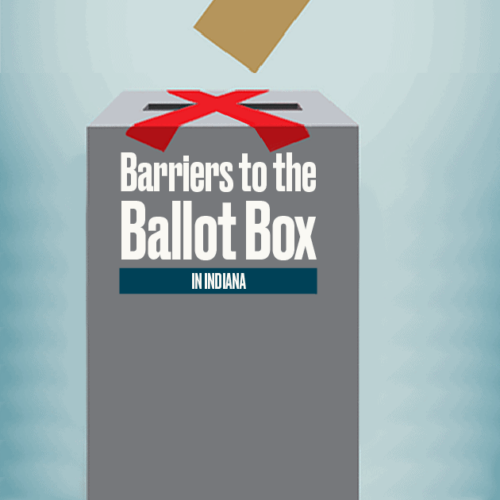Introduction
About two dozen states have expanded mail-in voting to make it easier for people to vote during the COVID-19 pandemic. Indiana is not one of them.
The state is one of five, including Texas and Louisiana, that have fought public pressure to allow all registered voters to cast a ballot by mail. Under current rules, Indiana voters need an excuse to vote absentee, such as being out of town on Election Day.
Sign up for The Moment newsletter
Our CEO Susan Smith Richardson guides you through conversations and context on race and inequality.
Lawmakers in Indiana have been focused on making it harder, not easier, to vote. In 2019, the state passed a law that gave voters fewer days to request an absentee ballot and a law that banned voters from asking a judge to keep polls open longer if a polling station was having problems. A federal judge struck down the latter law in September.
Indiana was one of the first states to require voters to show a photo ID at polling places, a practice that depresses Black and Latino turnout. The state’s strict photo ID law, passed in 2005, was upheld by the U.S Supreme Court in 2008, opening the door for other states to follow suit. Kansas and Tennessee were among half a dozen states that did.
Indiana also shuts off voter registration 29 days before Election Day — the earliest date allowed under federal law.
Here are two other issues that risk disenfranchising voters in Indiana:
Aggressive voter registration purges
Election officials are supposed to keep voter rolls “up to date” under federal law. But voting rights advocates say Indiana went a step farther than most states by letting local elections officials cancel the registrations of Indiana voters without telling them.
For years, the state checked to see if Indiana voters were registered to vote in another state through the Interstate Voter Registration Crosscheck Program, which was launched by former Kansas Secretary of State Kris Kobach. If there was a match, Indiana let counties throw out a voter’s registration without alerting them starting in 2017.
Voting rights groups challenged the law by filing a lawsuit later that year, saying the Crosscheck program was unreliable. The program, they said, could lead to the removal of voters whose names were similar to people in other states but who hadn’t actually moved. It was also more likely to flag minority voters. For example, researchers at Stanford and Harvard found that Crosscheck’s automated system incorrectly flagged people as possible double voters more than 99% of the time. The program was shut down in 2018, but Indiana created a nearly identical program under the new law.
The lawsuit argued that Indiana’s law violates the National Voter Registration Act, which requires a notice and waiting period before a state can remove a voter who changes addresses. That gives voters a chance to respond before their registration is cancelled.
“Given the background that, historically, vote purges have been used in the past as one method for suppressing minority voters, this should cause serious concern,” Jan Mensz, a staff attorney at the American Civil Liberties Union of Indiana, said at a voting rights hearing in March before the U.S. Commission on Civil Rights.
In August, the 7th Circuit Court of Appeals ruled in favor of the ACLU and other voting rights groups, blocking the state from throwing out registrations without notifying voters.
It’s unclear how many registrations Indiana canceled without notifying voters. Between the 2016 and 2018 elections, Indiana removed 28.7% of voter registrations from its rolls — far more than any other state, according to data from the U.S. Election Assistance Commission.
Cuts to early voting locations
In May of 2017, Common Cause Indiana and two branches of the NAACP challenged an early voting law in Marion County, home to large Black and Latino communities.
President Barack Obama had narrowly carried Indiana in 2008, largely because of African-American and Latino support in Marion County, which includes Indianapolis.
The Marion County Board of Elections then cut the number of early voting sites in the following years.
Between 2000 and 2016, officials reduced the number of early voting stations in the county from three to one, resulting in a 26% decline in absentee votes in the 2016 presidential election (early voters use absentee ballots in Indiana).
At the same time, officials added two early voting stations to the neighboring Hamilton County, which is home to many White Republicans.
The U.S. Commission on Civil Rights warned in July that these changes disenfranchised people of color and the elderly who live in Marion County.
“The resulting long lines likely produced hardships in voting based on work and childcare schedules and transportation availability” wrote the Indiana Advisory Committee to the U.S. Commission on Civil Rights in July.
The lawsuit reached the 7th Circuit Court of Appeals, which dismissed the case after Marion County changed its voting system. Instead of the traditional system of assigning voters to a neighborhood polling station, the county opened vote centers where any registered voter in the county can cast a ballot. The county also agreed to open six early voting centers for the general election.
Read more in Money and Democracy
US Polling Places
In Massachusetts, removing barriers to voting boosts turnout
But local disparities and felony disenfranchisement disproportionately stand in the way of voters of color.
US Polling Places
Voter registration isn’t available online in Wyoming, creating hurdles for residents
The ‘Equality State’ is the only one that requires a notary for registering to vote by mail.


Join the conversation
Show Comments